This 4K Ultra HD “Limited Edition” release from Arrow Video is currently available for purchase.

In 1969, a novel by young and relatively unknown writer Michael Crichton arrived on bookshelves. Crichton had written several pulp titles by this point, but The Andromeda Strain was the first released under his own name. It garnered a lot of press and soon ended up on the New York Times bestseller list. As with any successful book, it wasn’t long before Hollywood came knocking. The film rights were sold and a high-profile adaptation arrived at cinemas. This movie was only moderately successful, but it paved the way for Crichton’s career. In addition to completing more hugely popular novels like The Terminal Man, Congo, Sphere, Jurassic Park, Rising Sun, and Disclosure, he began writing screenplays for major studios, including Westworld, Coma, Looker, Runaway (as well as receiving co-writing credit on Twister).
Arrow Video is now giving his first big title, The Andromeda Strain, a major upgrade with a 4K Ultra HD “Limited Edition” release. The original negative has been restored and scanned in 4K and is presented in Dolby Vision, offering a vastly superior picture to previous editions. This is an older title, which means that there is a certain amount of natural grain present in some shots, but nothing that is distracting in any way. This reviewer was very impressed by the end result. Having only seen the movie on DVD and Blu-ray, the colors are richer, the image sharper and the overall picture is vastly improved.
If you haven’t seen the movie, the story begins with a satellite crashing down in a small town in New Mexico. Immediately, military officials fly overhead and note that everyone appears to be deceased. A team of scientists are visited by government officials and are forced to investigate. The first is bacteriologist Dr. Jeremy Stone (Arthur Hill), who appears to already be familiar with the official program he has been asked to lead. The others secretly taken include pathologist Dr. Charles Dutton (David Wayne), microbiologist Dr. Ruth Leavitt (Kate Reid) and surgeon Dr. Mark Hall (James Reid). Dressed in hazmat suits, Stone and Hall are dropped into town. Things look grim, but the pair collect samples and are eventually shocked to discover two survivors, a baby and the town drunk, Peter Jackson (George Mitchell).
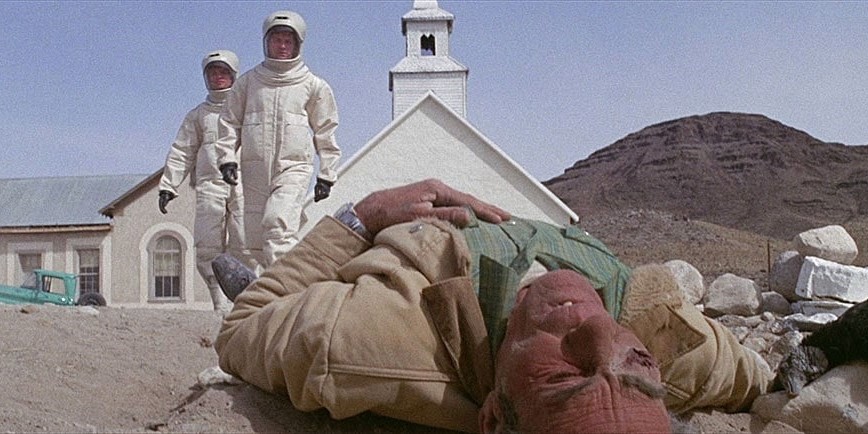
The entire group return to a new, high-tech, secret government laboratory underground where they attempt to identify the microscopic airborne organism responsible. The foursome debate about what is going on, but eventually discover that it is alien in origin and quickly clots blood in humans (to the point where their plasma looks as if it has turned to dust). They name the strain Andromeda and also learn that the government may have plans for the organism. In addition, it ultimately becomes clear that there is a disturbing design flaw in the facility that may end up releasing the killer substance back into the world.

The film does an admirable job of introducing believable scientist characters. They all have their eccentricities and quirks that feel authentic. Stone is icy in general, while Leavitt consistently pipes up to complain about their treatment and essentially being held (almost against her will) in the laboratory. If one were to pick a hero in this tale, Hall stands out as the surgeon. He is the most relatable, because while the others toil on minutia and specifics about the organism, his focus seems to be more about the health of those infected and still alive.

This picture is considered an early “techno-thriller” and does its best to take on a more realistic tone than other titles of the era. It takes time to show the decontamination process for the team, as well as how specific operations work both in the lab and with the military. The filmmaker appears to have tried to be as up-to-date as possible with technology and equipment in creating the secret government lab. The effects are very good for the era and were created by Douglas Trumbull (2001: A Space Odyssey; Silent Running).
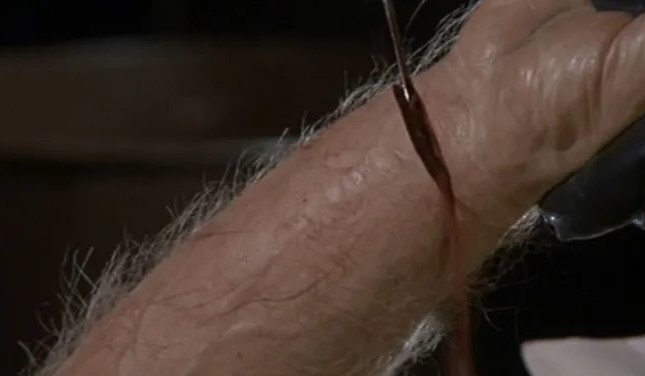
As mentioned, the stakes are high, which results in plenty of tension as well. The first act is very chilling as individuals search the mysterious site for survivors. The deadliness of the organism and the ticking clock force the leads to work as fast as they can before the military steps in, and the ticking clock keeps the pace lively. Additionally, the climax, which features a potential leak and Hall’s efforts to move through an infected area and find the machine that will prevent a disaster, is exciting and results in a wince-inducing injury.
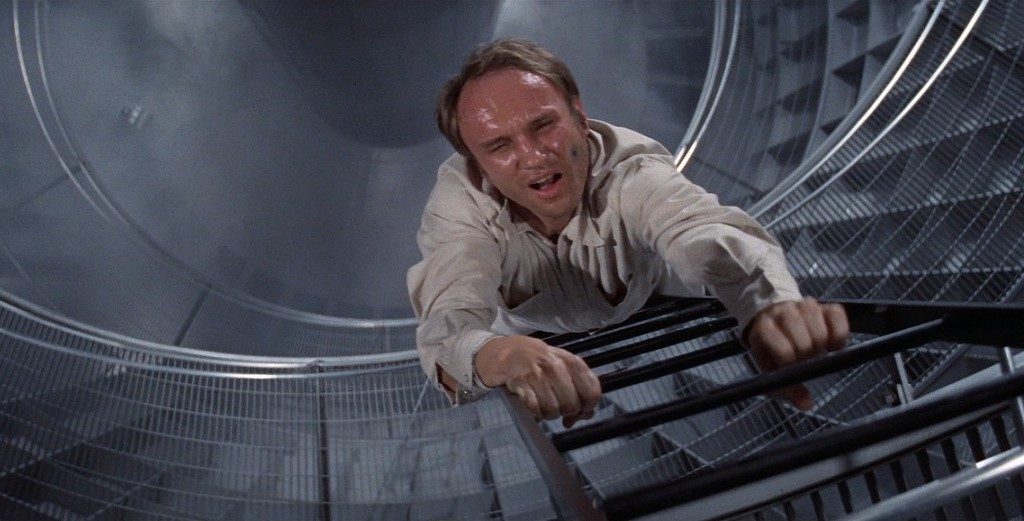
It’s an excellent feature and one that certainly led to more pictures attempting more accurately in telling stories like these. This is a definite forerunner to Contagion, and even the 2019 miniseries Chernobyl, as well as many other efforts dealing with viruses, plagues, pandemics and deadly health threats.
In addition to the movie, there are a great number of fascinating extras on this release. The first is an informative film historian commentary track that goes over details involving the production, the cast and crew, pointing out clever filmmaking techniques and sound design used to liven up the proceedings. This is most evident as the Stone and Hill search the town, with some great low and overhead angles. Also memorable are the interior-set still images of dead bodies inserted into wide shots of the protagonists outdoors, peering through windows while searching the ground zero site.
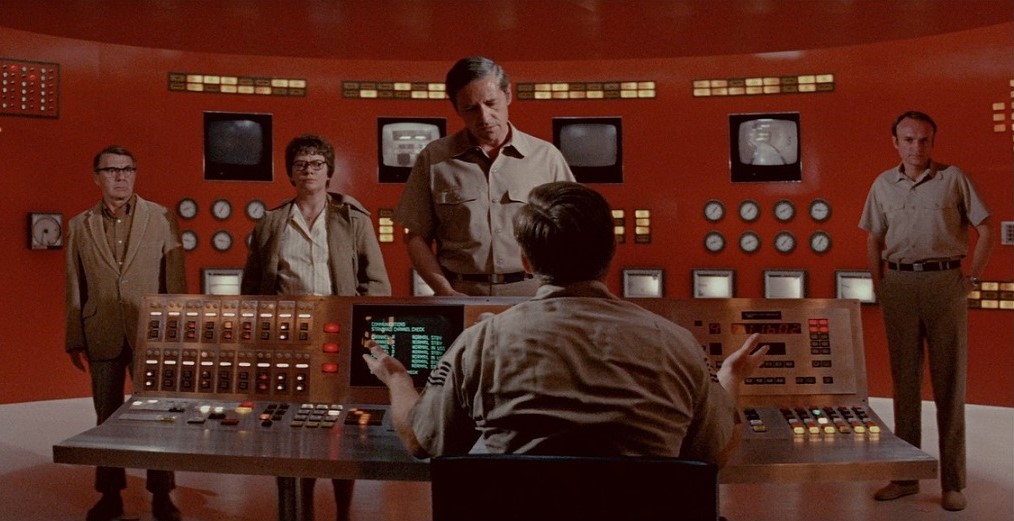
There is a discussion with Kim Newman about dramatic films and writing dealing with these types of pictures. Sometimes, the threats come from Earth virus, others from outer space. Some take a realistic approach, others fantastical. He notes features early tales like Edgar Allen Poe’s 1842 short story The Mask of the Red Death and features including 1950’s Panic in the Streets, The Quatermass Experiment in 1955, all the way through modern efforts, as well as zombie pictures and titles like John Carpenter’s The Thing, discussing the common traits, often identifying many of the effective and compelling aspects contained in the projects. This nearly 30-minute discussion is extremely informative and will leave many adding more titles to their watch lists.
Additionally, there are great archival features. Produced in 2001, there is a making-of featuring interviews with director Robert Wise (The Day the Earth Stood Still, West Side Story, The Haunting, The Sound of Music, Star Trek: The Motion Picture) as well as cast and crew members about what attracted them to the material and how they adapted the book. It seems that Wise read the novel and found it gripping. He appreciated the technical details, which made the story seem real, and chose to go in that direction, even avoiding casting big name stars in order to maintain authenticity. Wise preferred that Crichton not be involved in the screenplay adaptation, explaining why (which the author didn’t have an issue with). Additionally, they go into how one hard-to-watch experiment scene was conducted (remarkably, it was supervised and approved by the SPCA).

There is also an excellent discussion with Michael Crichton, who talks about his early career. He remembers being a medical student, writing stories as a hobby and eventually finding a publisher. Knowing that the MDs and those above him would be, well, dismissive of his writing, he used a pseudonym so that he would not have to deal with them during his medical studies. He eventually chose to focus exclusively on writing, which led to him agreeing to use his real name on The Andromeda Strain. The title for the story had come to him many years before, and he slowly worked out a scenario that resulted in the finished book.
Apparently, Crighton was really impressed with the changes made to his source material, in particular changing the sex of the microbiologist from male to female. In fact, Crichton and others in various special features note that this is an early example of a brilliant female character presented on equal footing with her male compatriots. It does make the movie feel more modern and the author regrets not having done that in the original story. He also talks about his brief cameo in the feature (the only time he has ever appeared onscreen). And Crichton also goes into his writing methods and the inspiration for his works. It’s a really wonderful and engaging talk.
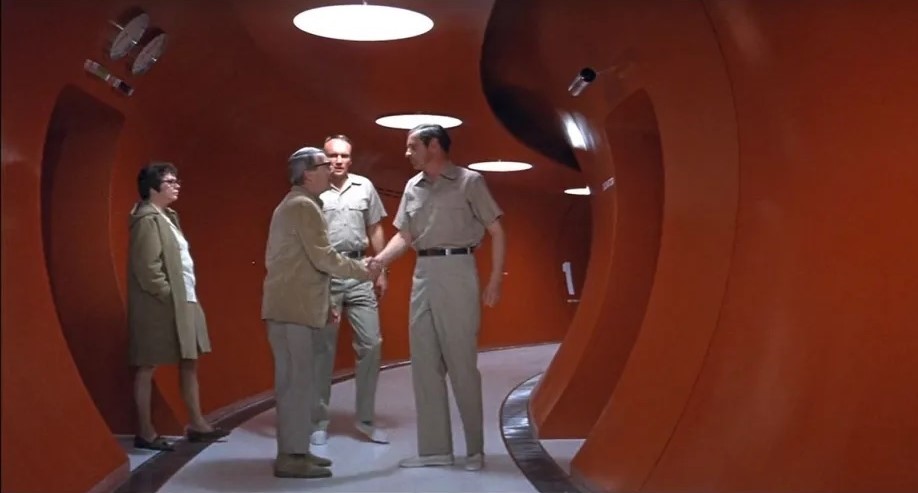
There are a number of trailers, TVs and radio spots for the film, as well as a still gallery. Additionally, an annotated and illustrated shooting script is included.
It all comes in a reversible sleeve featuring original and newly commissioned art for the feature.
This reviewer found revisiting The Andromeda Strain very interesting. The image quality on display looks far more vibrant than it ever has before and the movie is a tense thriller that has become increasingly relevant and interesting, especially over the past few years. The extras are enlightening as well, and will make viewers want to pick up a few Crichton titles and watch more films they may not have seen or watched in a long time. This is another great 4K Ultra HD release from Arrow Video that comes highly recommended.


